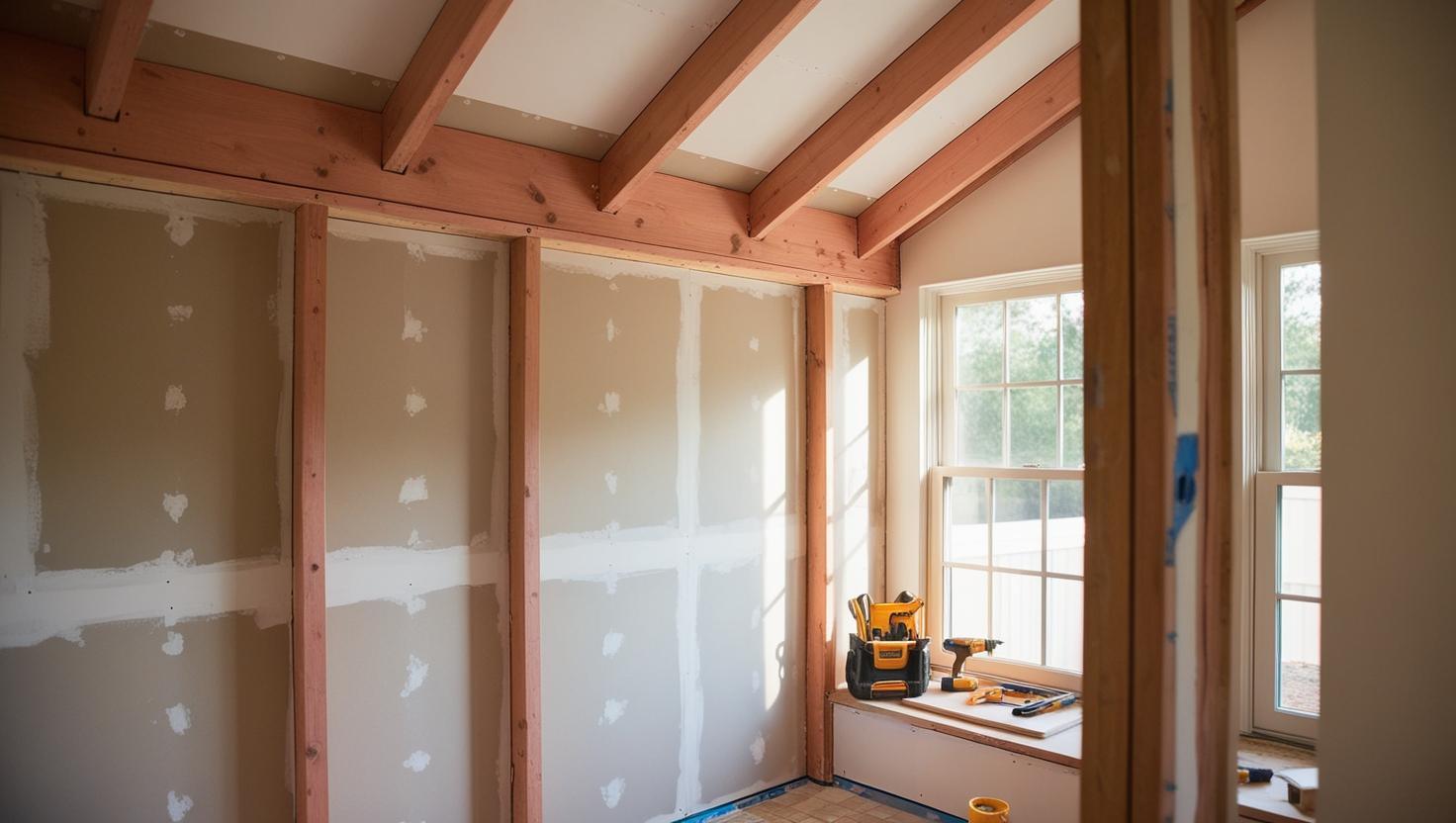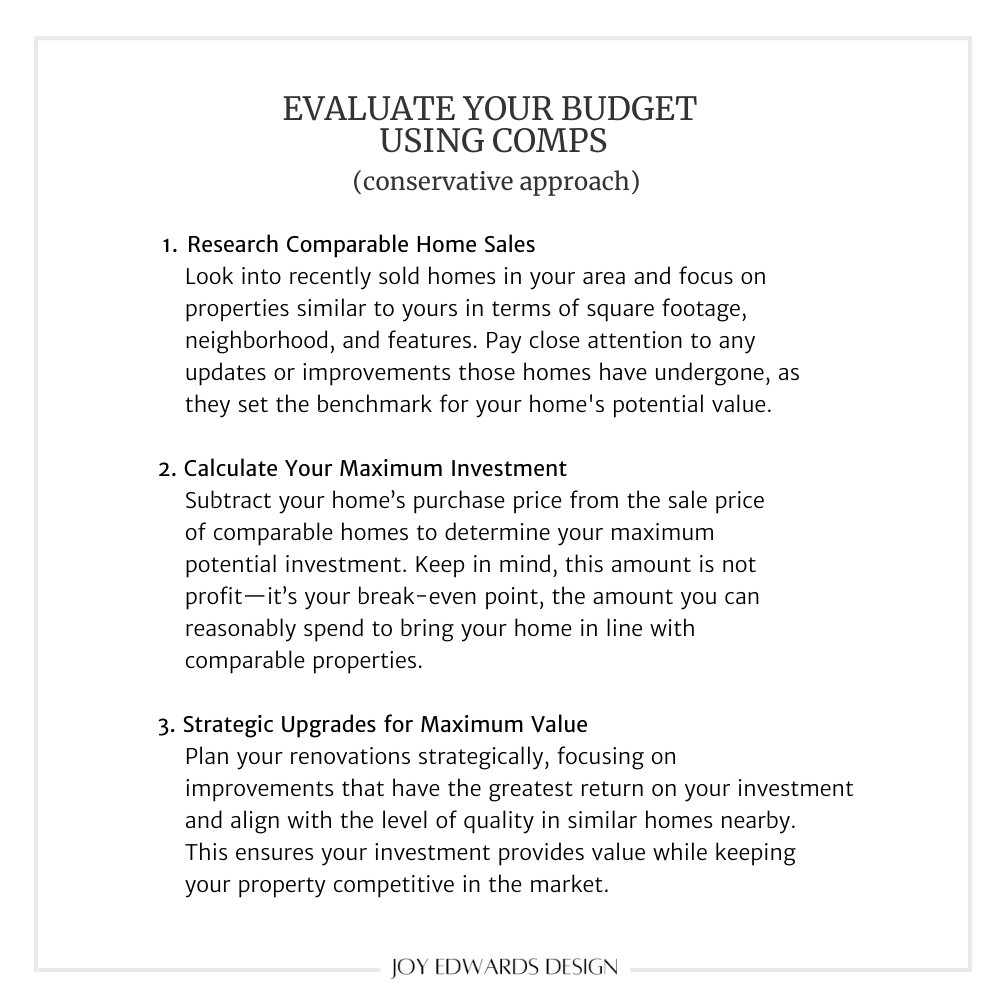How to Create a Budget for Your Home Project
by Joy Edwards Design
August 3, 2024

Starting Your Project: Developing Your Budget Strategy
Every successful interior design project starts with two key questions: What do you want to achieve? and How much are you ready to invest?
To answer these effectively, it’s important to identify the type of project you’re undertaking. This will determine your approach to budgeting for your home project. Budgets typically fall into one or two categories: Renovation and Furnishing Budget Strategies. Each approach highlights different parameters to help you align your vision with your investment.
Renovation Budget Strategy focuses on the structural and permanent updates to your home, like kitchens, bathrooms, or new flooring. Here’s the important thing to know—your investment should align with your home’s value, especially if resale is on your mind. Overspending could mean you won’t recoup your costs if you are looking at short term ownership.
Furnishing Budget Strategy, on the other hand, is all about personal style and comfort. Since furnishings are typically not included in your home’s resale value (aside from exceptions like custom window treatments), this budget is about what you value. Whether you prioritize high-quality pieces that stand the test of time or prefer to keep things more budget-friendly, the decision comes down to your preferences.
Let's dive deeper into each strategy of budgeting for your home project to set realistic expectations.
Renovation Budget Strategy

Many people use the term renovation to describe everything from updating finishes to making major structural changes like moving walls or altering plumbing. Technically, those larger changes fall under a remodel, but for simplicity, we’ll use the term renovation to cover both.
How to estimate your renovation budget?
There are two common approaches to determining a reasonable renovation budget: the Conservative Approach and the Long Term Approach.
- The Conservative Approach: Ideal for those planning to sell their home within the next 5 years, it focuses on keeping costs aligned with comps in the area to ensure you can recoup your investment when it’s time to sell. Below are steps you can take to create a reasonable budget for your renovation.

- The Long-Term Approach: Designed for homeowners with a longer outlook. This strategy breaks down each room by investment percentages, balancing spending with the overall value and functionality of the home over time and setting parameters for budgeting for your home project.

Evaluating these two approaches helps you make a more informed decision about budgeting for your renovation. Whether you are planning to sell in a few years or stay for many more years, you can have confidence knowing you are making the right decisions for your investment and your family.
Furnishing Budget Strategy

Furnishing a room—or an entire home—might seem straightforward, but the costs often add up faster than expected. Why? Because finishing a space involves much more than just budgeting for furniture. While furniture accounts for the bulk of your spending, it typically makes up only about 60% of your total furnishing budget.
If you’re planning to complete a room in a matter of months, rather than years, it’s crucial to understand how a budget can increase so quickly. Dividing your budget into the following three categories and percentages is the best strategy to estimate your furnishing budget:
- Furniture (60%): the core pieces in your space
- Accessories (25%): items like rugs, window treatments, art, and decor
- Tax & Shipping (15%): often overlooked costs that come with every purchase
Accessories and Tax & Shipping account for approximately 40% of the budget. Understanding this should partially alleviate confusion surrounding interior designer estimates. Depending on where you live, 15% for Tax & Shipping might actually be on the low end if your tax is greater than 6.5%. Shipping can also be more than tax, especially when storage, delivery and removal fees are included.
The inside scope on accessories is that you need far more than you realize to complete a space. You should plan to purchase at least 20 to 30 accessories, which I'm sure sounds excessive, but in reality, it's not. Below is a list of 30 basic items that are need for a finished living room design. Need to add decor for shelves? That number can easily double or even triple.
Think about this - if each accessory costs $100, that would be $3000 for 30 accessories. If that sounds like more than you would expect, it's actually going to be even more than that. Why? Light fixtures, area rugs, window treatments, art work and mirrors can easily range from $500 to $10,000 for an individual piece, depending on the quality, style and customization you desire.

Budget Example
Understanding the big picture of how all these pieces come together is important. I have included three examples using the percentages with different furnishing budgets. Since most people base their room budget on how much they expect to spend on furniture, I have place the furniture budget at the top.
If you are also considering hiring an interior designer, I have included our three services and how they fit with each type of furniture budget. Have a smaller or larger budget than what is list? Not a problem, the Entry Level Design fee would stay the same and the Full Service Design fee would be adjusted for the scope of work.
Finally, you will see on the chart different investments for light construction. This estimate may or may not be included in your project, and it may be more or less than the amount that is listed. These numbers simply provide a starting point to understand all the pieces that might be included when budgeting for your home project.
Living Room Budget Strategy Example
- Entry-Level Design:
-
- Furniture Budget: $12,360
- Total Furnishings: $20,600
- Total Investment: $25,000
- Includes a $650 design consultation fee and a small contractor fee for light renovations
- Mid-Level Design:
- Furniture Budget: $25,000
- Total Furnishings: $41,500
- Total Investment: $56,025
- Includes design fees and contractor fee for light renovations
- Full-Service Design:
- Furniture Budget: $45,000
- Total Furnishings: $75,000
- Total Investment: $101,250
- Includes design fees and contractor fee for light renovations

Why Developing Your Budget Strategy Matters
Understanding how to create your own Renovation Budget Strategy and Furnishing Budget Strategy alleviates confusion when it comes to project costs. It also provides a valuable stepping stone towards a realistic design budget, allowing you to begin answering the two key questions: What do you want to achieve? and How much are you ready to invest?
If you hire Joy Edwards Design for your next project, we will start by defining your budget strategy. We will then work with you to bring that into focus to create a detailed, itemized budget. We believe clarity is a wonderful thing and transparency is what every client deserves.
COMPLIMENTARY
Discovery Call
Uncover the possibilities. Let's bring your dream to life!
